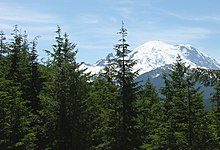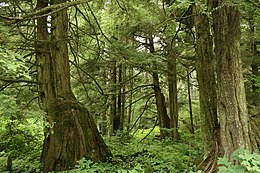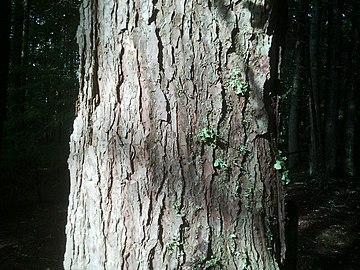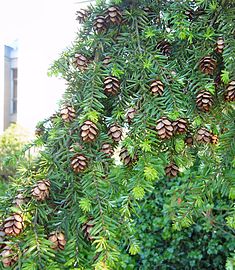Tsuga heterophylla
| Western hemlock | |
|---|---|

| |
| Scientific classification | |
| Kingdom: | Plantae |
| Clade: | Tracheophytes |
| Clade: | Gymnospermae |
| Division: | Pinophyta |
| Class: | Pinopsida |
| Order: | Pinales |
| Family: | Pinaceae |
| Genus: | Tsuga |
| Species: | T. heterophylla
|
| Binomial name | |
| Tsuga heterophylla | |

| |
| Natural range | |
Tsuga heterophylla, the western hemlock[2] or western hemlock-spruce,[3] is a species of hemlock native to the west coast of North America, with its northwestern limit on the Kenai Peninsula, Alaska, and its southeastern limit in northern Sonoma County, California.[4][5] The Latin species name means 'variable leaves'.[6]
Description
[edit]Western hemlock is a large evergreen conifer growing to 50–70 metres (165–230 feet) tall, exceptionally 83 m (273 ft),[7] and with a trunk diameter of up to 2.7 m (9 ft). It is the largest species of hemlock, with the next largest (mountain hemlock) reaching a maximum height of 59 m (194 ft). The bark is brown, thin, and furrowed (outwardly appearing similar to that of Douglas-fir).[6] The crown is a very neat broad conic shape in young trees with a strongly drooping lead shoot, becoming cylindrical in older trees, which may have no branches in the lowest 30–40 m (100–130 ft). At all ages, it is readily distinguished by the pendulous branchlet tips. The shoots are very pale buff-brown, almost white, with pale pubescence about 1 millimetre (1⁄32 in) long.
The leaves are needle-like, 5–23 mm (3⁄16–29⁄32 in) long and 1.5–2 mm (1⁄16–3⁄32 in) broad, strongly flattened in cross-section, with a finely serrated margin and a bluntly acute apex. They are mid to dark green above; the underside has two distinctive white bands of stomata with only a narrow green midrib between the bands. They are arranged spirally on the shoots but are twisted at the base to lie in two ranks on either side of the shoot. The cones appear on trees over about 25 years old;[6] they are small, pendulous, slenderly cylindrical, 14–30 mm (9⁄16–1+3⁄16 in) long and 7–8 mm (9⁄32–5⁄16 in) broad when closed, opening to 18–25 mm (23⁄32–31⁄32 in) broad. They have 15–25 thin, flexible scales 7–13 mm (9⁄32–1⁄2 in) long. The immature cones are green, maturing gray-brown 5–7 months after pollination. They are usually plentiful enough to cover the ground beneath the tree.[6] The abundant seeds are brown, 2–3 mm (3⁄32–1⁄8 in) long, with a slender, pale-brown wing measuring 7–9 mm (9⁄32–11⁄32 in) long.[4][5][6]
Initial growth is slow; one-year-old seedlings are commonly only 3–5 centimetres (1+1⁄8–2 in) tall, and two-year-old seedlings 10–20 cm (4–8 in) tall. Once established, saplings in full light may have an average growth rate of 50–120 cm (20–47 in) (rarely 140 cm, 55 in) annually until they are 20–30 m (65–100 ft) tall, and in good conditions still 30–40 cm (12–16 in) annually when 40–50 m (130–165 ft) tall. The tallest specimen, 82.83 m (271 ft 9 in) tall, is in Prairie Creek Redwoods State Park, California (United States). The species is long-lived, especially at higher elevations,[6] with trees over 1,200 years old known.[5]
Distribution and habitat
[edit]
T. heterophylla is an integral component of Pacific Northwest forests west of the Coast Ranges, where it is a climax species. It is also an important timber tree throughout the region, along with many of its large coniferous associates.[8] The species is closely associated with temperate rainforests, and most of its range is less than 100 kilometres (62 miles) from the Pacific Ocean. Valleys it can be found in usually receive at least 80 cm (31 in) of rain annually.[6] It mostly grows at low altitudes, from sea level to 600 m (2,000 ft). In western Washington, it can be found up to elevations of 1,070 m (3,510 ft).[6] The species can also be found in humid areas of mountains further inland, where western white pine is normally dominant.[6] For example, in the Columbia Mountains in and around southeastern British Columbia and northern Idaho, it grows up to 1,500 m (4,900 ft), particularly on north-facing slopes.[6] In the interior part of its range in Idaho, it can be found up to 1,800 m (5,900 ft).[4][5]
Ecology
[edit]Western hemlock is a very shade-tolerant tree; among associated species in the Pacific Northwest, it is matched or exceeded in shade tolerance only by Pacific yew and Pacific silver fir.[8] Young plants typically grow up under the canopy of other conifers such as Sitka spruce or Douglas-fir, where they can persist for decades waiting to exploit a gap in the canopy. They eventually replace these conifers, which are relatively shade-intolerant, in climax forest. However, storms and wildfires will create larger openings in the forest where these other species can then regenerate. Its thin bark and shallow roots makes it susceptible to fire.[6] At higher elevations, the species can be found mingling with T. mertensiana (mountain hemlock), seeming to take on some of its characteristics although there is no hard evidence of hybridization.[6]
Western hemlock forms ectomycorrhizal associations with some well-known edible fungi such as chanterelles (Cantharellus formosus, C. subalbidus, and Craterellus tubaeformis).[9][10] It is capable of associating with wood-decay fungi in addition to soil fungi; this enables its seedlings to survive on rotting stumps and logs.[11] Older forests are damaged by rot-causing fungi, dwarf mistletoe, and leaf-consuming insects such as Acleris gloverana and Lambdina fiscellaria.[6]
Uses
[edit]The bark has long served as a source of tannin for tanning leather.[6]
Cultivation
[edit]Western hemlock is cultivated as an ornamental tree in gardens in its native habitats and along the U.S. Pacific Coast, where its best reliability is seen in wetter regions. In relatively dry areas, as at Victoria, British Columbia, it is exacting about soil conditions. It needs a high level of organic matter (well-rotted wood from an old log or stump is best; animal manures may have too much nitrogen and salt), in a moist, acidic soil. It is also cultivated in temperate regions worldwide. It has gained the Royal Horticultural Society's Award of Garden Merit.[12][13]
It can also be found in large gardens in northwest Europe and southern New Zealand.
Forestry
[edit]When planted on the banks of a river, western hemlock can help reduce erosion. Outside of its natural range, the tree is of importance in forestry.
Until the early 1920s, the tree was largely ignored for use as lumber due to its presumed similarity to the poor-quality eastern hemlock.[6] Since then, it has been greatly utilized for timber (as a softwood) and paper production;[6] it is used for making doors, joinery, and furniture.[14] Its fiber is used to make rayon and various plastics.[6]
It has naturalised in some parts of Great Britain and New Zealand—not so extensively as to be considered an invasive species, but as an introduced one.
Food and medicine
[edit]The edible cambium can be collected by scraping slabs of removed bark. The resulting shavings can be eaten immediately, or can be dried and pressed into bread, as was done by the natives of Southeast Alaska.[15] The inner bark was eaten by some Native American tribes as an emergency food, and the bark was cooked to make medicinal extracts for tuberculosis, rheumatic fever, and hemorrhage.[6] The bark could also be boiled to make dark red dyes to make fishing nets and lines less visible to fish.[6]
Western hemlocks have been submerged to collect herring eggs[6] during the spring spawn in southeast Alaska. The boughs provide an easily collectible surface for the eggs to attach to[6] as well as providing a distinctive taste. This practice originates from traditional gathering methods used by Native Alaskans from southeast Alaska, specifically the Tlingit people.[citation needed]
Tender new-growth needles can be chewed directly or made into a bitter tea, rich in vitamin C (similar to some other hemlock and pine species).[citation needed]
Culture
[edit]Western hemlock is the state tree of Washington.[16]
References
[edit]- ^ Farjon, A. (2013). "Tsuga heterophylla". IUCN Red List of Threatened Species. 2013: e.T42435A2980087. doi:10.2305/IUCN.UK.2013-1.RLTS.T42435A2980087.en. Retrieved 19 November 2021.
- ^ USDA, NRCS (n.d.). "Tsuga heterophylla". The PLANTS Database (plants.usda.gov). Greensboro, North Carolina: National Plant Data Team. Retrieved 12 December 2015.
- ^ BSBI List 2007 (xls). Botanical Society of Britain and Ireland. Archived from the original (xls) on 26 June 2015. Retrieved 17 October 2014.
- ^ a b c Farjon, A. (1990). Pinaceae. Drawings and Descriptions of the Genera. Koeltz Scientific Books ISBN 3-87429-298-3.
- ^ a b c d Gymnosperm Database: Tsuga heterophylla Archived 2005-09-24 at the Wayback Machine
- ^ a b c d e f g h i j k l m n o p q r s t u Arno, Stephen F.; Hammerly, Ramona P. (2020) [1977]. Northwest Trees: Identifying & Understanding the Region's Native Trees (field guide ed.). Seattle: Mountaineers Books. pp. 110–117. ISBN 978-1-68051-329-5. OCLC 1141235469.
- ^ Tallest Hemlock, M. D. Vaden, Arborist: Tallest known Hemlock, Tsuga heterophylla
- ^ a b Packee, E.C. (1990). "Tsuga heterophylla". In Burns, Russell M.; Honkala, Barbara H. (eds.). Conifers. Silvics of North America. Vol. 1. Washington, D.C.: United States Forest Service (USFS), United States Department of Agriculture (USDA) – via Southern Research Station.
- ^ Dunham, Susie M.; O'Dell, Thomas E.; Molina, Randy (2006). "Forest stand age and the occurrence of chanterelle (Cantharellus) species in Oregon's central Cascade Mountains" (PDF). Mycological Research. 110 (12): 1433–40. doi:10.1016/j.mycres.2006.09.007. PMID 17123812. Archived from the original (PDF) on 14 August 2011.
- ^ Trappe, MJ (May–June 2004). "Habitat and host associations of Craterellus tubaeformis in northwestern Oregon". Mycologia. 96 (3): 498–509. doi:10.2307/3762170. JSTOR 3762170. PMID 21148873.
- ^ "Fungi from decayed wood as ectomycorrhizal symbionts of western hemlock". Archived from the original on 13 March 2018.
- ^ "RHS Plant Selector – Tsuga heterophylla". RHS. Retrieved 5 March 2021.
- ^ "AGM Plants - Ornamental" (PDF). Royal Horticultural Society. July 2017. p. 103. Retrieved 27 December 2018.
- ^ Buckley, Michael (2005). "A basic guide to softwoods and hardwoods" (PDF). worldhardwoods.com. Retrieved 1 October 2017.
- ^ Whitney, Stephen (1985). Western Forests (The Audubon Society Nature Guides). New York: Knopf. p. 416. ISBN 0-394-73127-1.
- ^ "State Symbols". Washington State Government. Archived from the original on 15 November 2007. Retrieved 20 February 2022.






